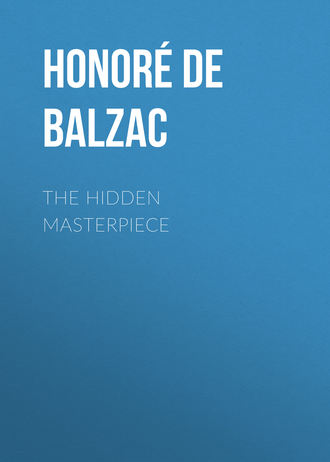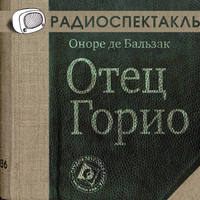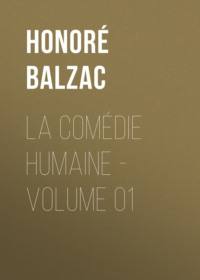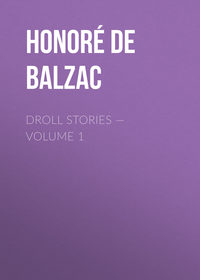 полная версия
полная версияThe Hidden Masterpiece

Honoré de Balzac
The Hidden Masterpiece
CHAPTER I
On a cold morning in December, towards the close of the year 1612, a young man, whose clothing betrayed his poverty, was standing before the door of a house in the Rue des Grands-Augustine, in Paris. After walking to and fro for some time with the hesitation of a lover who fears to approach his mistress, however complying she may be, he ended by crossing the threshold and asking if Maitre Francois Porbus were within. At the affirmative answer of an old woman who was sweeping out one of the lower rooms the young man slowly mounted the stairway, stopping from time to time and hesitating, like a newly fledged courier doubtful as to what sort of reception the king might grant him.
When he reached the upper landing of the spiral ascent, he paused a moment before laying hold of a grotesque knocker which ornamented the door of the atelier where the famous painter of Henry IV. – neglected by Marie de Medicis for Rubens – was probably at work. The young man felt the strong sensation which vibrates in the soul of great artists when, in the flush of youth and of their ardor for art, they approach a man of genius or a masterpiece. In all human sentiments there are, as it were, primeval flowers bred of noble enthusiasms, which droop and fade from year to year, till joy is but a memory and glory a lie. Amid such fleeting emotions nothing so resembles love as the young passion of an artist who tastes the first delicious anguish of his destined fame and woe, – a passion daring yet timid, full of vague confidence and sure discouragement. Is there a man, slender in fortune, rich in his spring-time of genius, whose heart has not beaten loudly as he approached a master of his art? If there be, that man will forever lack some heart-string, some touch, I know not what, of his brush, some fibre in his creations, some sentiment in his poetry. When braggarts, self-satisfied and in love with themselves, step early into the fame which belongs rightly to their future achievements, they are men of genius only in the eyes of fools. If talent is to be measured by youthful shyness, by that indefinable modesty which men born to glory lose in the practice of their art, as a pretty woman loses hers among the artifices of coquetry, then this unknown young man might claim to be possessed of genuine merit. The habit of success lessens doubt; and modesty, perhaps, is doubt.
Worn down with poverty and discouragement, and dismayed at this moment by his own presumption, the young neophyte might not have dared to enter the presence of the master to whom we owe our admirable portrait of Henry IV., if chance had not thrown an unexpected assistance in his way. An old man mounted the spiral stairway. The oddity of his dress, the magnificence of his lace ruffles, the solid assurance of his deliberate step, led the youth to assume that this remarkable personage must be the patron, or at least the intimate friend, of the painter. He drew back into a corner of the landing and made room for the new-comer; looking at him attentively and hoping to find either the frank good-nature of the artistic temperament, or the serviceable disposition of those who promote the arts. But on the contrary he fancied he saw something diabolical in the expression of the old man’s face, – something, I know not what, which has the quality of alluring the artistic mind.
Imagine a bald head, the brow full and prominent and falling with deep projection over a little flattened nose turned up at the end like the noses of Rabelais and Socrates; a laughing, wrinkled mouth; a short chin boldly chiselled and garnished with a gray beard cut into a point; sea-green eyes, faded perhaps by age, but whose pupils, contrasting with the pearl-white balls on which they floated, cast at times magnetic glances of anger or enthusiasm. The face in other respects was singularly withered and worn by the weariness of old age, and still more, it would seem, by the action of thoughts which had undermined both soul and body. The eyes had lost their lashes, and the eyebrows were scarcely traced along the projecting arches where they belonged. Imagine such a head upon a lean and feeble body, surround it with lace of dazzling whiteness worked in meshes like a fish-slice, festoon the black velvet doublet of the old man with a heavy gold chain, and you will have a faint idea of the exterior of this strange individual, to whose appearance the dusky light of the landing lent fantastic coloring. You might have thought that a canvas of Rembrandt without its frame had walked silently up the stairway, bringing with it the dark atmosphere which was the sign-manual of the great master. The old man cast a look upon the youth which was full of sagacity; then he rapped three times upon the door, and said, when it was opened by a man in feeble health, apparently about forty years of age, “Good-morning, maitre.”
Porbus bowed respectfully, and made way for his guest, allowing the youth to pass in at the same time, under the impression that he came with the old man, and taking no further notice of him; all the less perhaps because the neophyte stood still beneath the spell which holds a heaven-born painter as he sees for the first time an atelier filled with the materials and instruments of his art. Daylight came from a casement in the roof and fell, focussed as it were, upon a canvas which rested on an easel in the middle of the room, and which bore, as yet, only three or four chalk lines. The light thus concentrated did not reach the dark angles of the vast atelier; but a few wandering reflections gleamed through the russet shadows on the silvered breastplate of a horseman’s cuirass of the fourteenth century as it hung from the wall, or sent sharp lines of light upon the carved and polished cornice of a dresser which held specimens of rare pottery and porcelains, or touched with sparkling points the rough-grained texture of ancient gold-brocaded curtains, flung in broad folds about the room to serve the painter as models for his drapery. Anatomical casts in plaster, fragments and torsos of antique goddesses amorously polished by the kisses of centuries, jostled each other upon shelves and brackets. Innumerable sketches, studies in the three crayons, in ink, and in red chalk covered the walls from floor to ceiling; color-boxes, bottles of oil and turpentine, easels and stools upset or standing at right angles, left but a narrow pathway to the circle of light thrown from the window in the roof, which fell full on the pale face of Porbus and on the ivory skull of his singular visitor.
The attention of the young man was taken exclusively by a picture destined to become famous after those days of tumult and revolution, and which even then was precious in the sight of certain opinionated individuals to whom we owe the preservation of the divine afflatus through the dark days when the life of art was in jeopardy. This noble picture represents the Mary of Egypt as she prepares to pay for her passage by the ship. It is a masterpiece, painted for Marie de Medicis, and afterwards sold by her in the days of her distress.
“I like your saint,” said the old man to Porbus, “and I will give you ten golden crowns over and above the queen’s offer; but as to entering into competition with her – the devil!”
“You do like her, then?”
“As for that,” said the old man, “yes, and no. The good woman is well set-up, but – she is not living. You young men think you have done all when you have drawn the form correctly, and put everything in place according to the laws of anatomy. You color the features with flesh-tones, mixed beforehand on your palette, – taking very good care to shade one side of the face darker than the other; and because you draw now and then from a nude woman standing on a table, you think you can copy nature; you fancy yourselves painters, and imagine that you have got at the secret of God’s creations! Pr-r-r-r! – To be a great poet it is not enough to know the rules of syntax and write faultless grammar. Look at your saint, Porbus. At first sight she is admirable; but at the very next glance we perceive that she is glued to the canvas, and that we cannot walk round her. She is a silhouette with only one side, a semblance cut in outline, an image that can’t turn nor change her position. I feel no air between this arm and the background of the picture; space and depth are wanting. All is in good perspective; the atmospheric gradations are carefully observed, and yet in spite of your conscientious labor I cannot believe that this beautiful body has the warm breath of life. If I put my hand on that firm, round throat I shall find it cold as marble. No, no, my friend, blood does not run beneath that ivory skin; the purple tide of life does not swell those veins, nor stir those fibres which interlace like net-work below the translucent amber of the brow and breast. This part palpitates with life, but that other part is not living; life and death jostle each other in every detail. Here, you have a woman; there, a statue; here again, a dead body. Your creation is incomplete. You have breathed only a part of your soul into the well-beloved work. The torch of Prometheus went out in your hands over and over again; there are several parts of your painting on which the celestial flame never shone.”
“But why is it so, my dear master?” said Porbus humbly, while the young man could hardly restrain a strong desire to strike the critic.
“Ah! that is the question,” said the little old man. “You are floating between two systems, – between drawing and color, between the patient phlegm and honest stiffness of the old Dutch masters and the dazzling warmth and abounding joy of the Italians. You have tried to follow, at one and the same time, Hans Holbein and Titian; Albrecht Durier and Paul Veronese. Well, well! it was a glorious ambition, but what is the result? You have neither the stern attraction of severity nor the deceptive magic of the chiaroscuro. See! at this place the rich, clear color of Titian has forced out the skeleton outline of Albrecht Durier, as molten bronze might burst and overflow a slender mould. Here and there the outline has resisted the flood, and holds back the magnificent torrent of Venetian color. Your figure is neither perfectly well painted nor perfectly well drawn; it bears throughout the signs of this unfortunate indecision. If you did not feel that the fire of your genius was hot enough to weld into one the rival methods, you ought to have chosen honestly the one or the other, and thus attained the unity which conveys one aspect, at least, of life. As it is, you are true only on your middle plane. Your outlines are false; they do not round upon themselves; they suggest nothing behind them. There is truth here,” said the old man, pointing to the bosom of the saint; “and here,” showing the spot where the shoulder ended against the background; “but there,” he added, returning to the throat, “it is all false. Do not inquire into the why and wherefore. I should fill you with despair.”
The old man sat down on a stool and held his head in his hands for some minutes in silence.
“Master,” said Porbus at length, “I studied that throat from the nude; but, to our sorrow, there are effects in nature which become false or impossible when placed on canvas.”
“The mission of art is not to copy nature, but to represent it. You are not an abject copyist, but a poet,” cried the old man, hastily interrupting Porbus with a despotic gesture. “If it were not so, a sculptor could reach the height of his art by merely moulding a woman. Try to mould the hand of your mistress, and see what you will get, – ghastly articulations, without the slightest resemblance to her living hand; you must have recourse to the chisel of a man who, without servilely copying that hand, can give it movement and life. It is our mission to seize the mind, soul, countenance of things and beings. Effects! effects! what are they? the mere accidents of the life, and not the life itself. A hand, – since I have taken that as an example, – a hand is not merely a part of the body, it is far more; it expresses and carries on a thought which we must seize and render. Neither the painter nor the poet nor the sculptor should separate the effect from the cause, for they are indissolubly one. The true struggle of art lies there. Many a painter has triumphed through instinct without knowing this theory of art as a theory.
“Yes,” continued the old man vehemently, “you draw a woman, but you do not see her. That is not the way to force an entrance into the arcana of Nature. Your hand reproduces, without an action of your mind, the model you copied under a master. You do not search out the secrets of form, nor follow its windings and evolutions with enough love and perseverance. Beauty is solemn and severe, and cannot be attained in that way; we must wait and watch its times and seasons, and clasp it firmly ere it yields to us. Form is a Proteus less easily captured, more skilful to double and escape, than the Proteus of fable; it is only at the cost of struggle that we compel it to come forth in its true aspects. You young men are content with the first glimpse you get of it; or, at any rate, with the second or the third. This is not the spirit of the great warriors of art, – invincible powers, not misled by will-o’-the-wisps, but advancing always until they force Nature to lie bare in her divine integrity. That was Raphael’s method,” said the old man, lifting his velvet cap in homage to the sovereign of art; “his superiority came from the inward essence which seems to break from the inner to the outer of his figures. Form with him was what it is with us, – a medium by which to communicate ideas, sensations, feelings; in short, the infinite poesy of being. Every figure is a world; a portrait, whose original stands forth like a sublime vision, colored with the rainbow tints of light, drawn by the monitions of an inward voice, laid bare by a divine finger which points to the past of its whole existence as the source of its given expression. You clothe your women with delicate skins and glorious draperies of hair, but where is the blood which begets the passion or the peace of their souls, and is the cause of what you call ‘effects’? Your saint is a dark woman; but this, my poor Porbus, belongs to a fair one. Your figures are pale, colored phantoms, which you present to our eyes; and you call that painting! art! Because you make something which looks more like a woman than a house, you think you have touched the goal; proud of not being obliged to write “currus venustus” or “pulcher homo” on the frame of your picture, you think yourselves majestic artists like our great forefathers. Ha, ha! you have not got there yet, my little men; you will use up many a crayon and spoil many a canvas before you reach that height. Undoubtedly a woman carries her head this way and her petticoats that way; her eyes soften and droop with just that look of resigned gentleness; the throbbing shadow of the eyelashes falls exactly thus upon her cheek. That is it, and – that is not it. What lacks? A mere nothing; but that mere nothing is all. You have given the shadow of life, but you have not given its fulness, its being, its – I know not what – soul, perhaps, which floats vaporously about the tabernacle of flesh; in short, that flower of life which Raphael and Titian culled. Start from the point you have now attained, and perhaps you may yet paint a worthy picture; you grew weary too soon. Mediocrity will extol your work; but the true artist smiles. O Mabuse! O my master!” added this singular person, “you were a thief; you have robbed us of your life, your knowledge, your art! But at least,” he resumed after a pause, “this picture is better than the paintings of that rascally Rubens, with his mountains of Flemish flesh daubed with vermilion, his cascades of red hair, and his hurly-burly of color. At any rate, you have got the elements of color, drawing, and sentiment, – the three essential parts of art.”
“But the saint is sublime, good sir!” cried the young man in a loud voice, waking from a deep reverie. “These figures, the saint and the boatman, have a subtile meaning which the Italian painters cannot give. I do not know one of them who could have invented that hesitation of the boatman.”
“Does the young fellow belong to you?” asked Porbus of the old man.
“Alas, maitre, forgive my boldness,” said the neophyte, blushing. “I am all unknown; only a dauber by instinct. I have just come to Paris, that fountain of art and science.”
“Let us see what you can do,” said Porbus, giving him a red crayon and a piece of paper.
The unknown copied the saint with an easy turn of his hand.
“Oh! oh!” exclaimed the old man, “what is your name?”
The youth signed the drawing: Nicolas Poussin.
“Not bad for a beginner,” said the strange being who had discoursed so wildly. “I see that it is worth while to talk art before you. I don’t blame you for admiring Porbus’s saint. It is a masterpiece for the world at large; only those who are behind the veil of the holy of holies can perceive its errors. But you are worthy of a lesson, and capable of understanding it. I will show you how little is needed to turn that picture into a true masterpiece. Give all your eyes and all your attention; such a chance of instruction may never fall in your way again. Your palette, Porbus.”
Porbus fetched his palette and brushes. The little old man turned up his cuffs with convulsive haste, slipped his thumb through the palette charged with prismatic colors, and snatched, rather than took, the handful of brushes which Porbus held out to him. As he did so his beard, cut to a point, seemed to quiver with the eagerness of an incontinent fancy; and while he filled his brush he muttered between his teeth: —
“Colors fit to fling out of the window with the man who ground them, – crude, false, revolting! who can paint with them?”
Then he dipped the point of his brush with feverish haste into the various tints, running through the whole scale with more rapidity than the organist of a cathedral runs up the gamut of the “O Filii” at Easter.
Porbus and Poussin stood motionless on either side of the easel, plunged in passionate contemplation.
“See, young man,” said the old man without turning round, “see how with three or four touches and a faint bluish glaze you can make the air circulate round the head of the poor saint, who was suffocating in that thick atmosphere. Look how the drapery now floats, and you see that the breeze lifts it; just now it looked like heavy linen held out by pins. Observe that the satiny lustre I am putting on the bosom gives it the plump suppleness of the flesh of a young girl. See how this tone of mingled reddish-brown and ochre warms up the cold grayness of that large shadow where the blood seemed to stagnate rather than flow. Young man, young man! what I am showing you now no other master in the world can teach you. Mabuse alone knew the secret of giving life to form. Mabuse had but one pupil, and I am he. I never took a pupil, and I am an old man now. You are intelligent enough to guess at what should follow from the little that I shall show you to-day.”
While he was speaking, the extraordinary old man was giving touches here and there to all parts of the picture. Here two strokes of the brush, there one, but each so telling that together they brought out a new painting, – a painting steeped, as it were, in light. He worked with such passionate ardor that the sweat rolled in great drops from his bald brow; and his motions seemed to be jerked out of him with such rapidity and impatience that the young Poussin fancied a demon, encased with the body of this singular being, was working his hands fantastically like those of a puppet without, or even against, the will of their owner. The unnatural brightness of his eyes, the convulsive movements which seemed the result of some mental resistance, gave to this fancy of the youth a semblance of truth which reacted upon his lively imagination. The old man worked on, muttering half to himself, half to his neophyte: —
“Paf! paf! paf! that is how we butter it on, young man. Ah! my little pats, you are right; warm up that icy tone. Come, come! – pon, pon, pon, – ” he continued, touching up the spots where he had complained of a lack of life, hiding under layers of color the conflicting methods, and regaining the unity of tone essential to an ardent Egyptian.
“Now see, my little friend, it is only the last touches of the brush that count for anything. Porbus put on a hundred; I have only put on one or two. Nobody will thank us for what is underneath, remember that!”
At last the demon paused; the old man turned to Porbus and Poussin, who stood mute with admiration, and said to them, —
“It is not yet equal to my Beautiful Nut-girl; still, one can put one’s name to such a work. Yes, I will sign it,” he added, rising to fetch a mirror in which to look at what he had done. “Now let us go and breakfast. Come, both of you, to my house. I have some smoked ham and good wine. Hey! hey! in spite of the degenerate times we will talk painting; we are strong ourselves. Here is a little man,” he continued, striking Nicolas Poussin on the shoulder, “who has the faculty.”
Observing the shabby cap of the youth, he pulled from his belt a leathern purse from which he took two gold pieces and offered them to him, saying, —
“I buy your drawing.”
“Take them,” said Porbus to Poussin, seeing that the latter trembled and blushed with shame, for the young scholar had the pride of poverty; “take them, he has the ransom of two kings in his pouch.”
The three left the atelier and proceeded, talking all the way of art, to a handsome wooden house standing near the Pont Saint-Michel, whose window-casings and arabesque decoration amazed Poussin. The embryo painter soon found himself in one of the rooms on the ground floor seated, beside a good fire, at a table covered with appetizing dishes, and, by unexpected good fortune, in company with two great artists who treated him with kindly attention.
“Young man,” said Porbus, observing that he was speechless, with his eyes fixed on a picture, “do not look at that too long, or you will fall into despair.”
It was the Adam of Mabuse, painted by that wayward genius to enable him to get out of the prison where his creditors had kept him so long. The figure presented such fulness and force of reality that Nicolas Poussin began to comprehend the meaning of the bewildering talk of the old man. The latter looked at the picture with a satisfied but not enthusiastic manner, which seemed to say, “I have done better myself.”
“There is life in the form,” he remarked. “My poor master surpassed himself there; but observe the want of truth in the background. The man is living, certainly; he rises and is coming towards us; but the atmosphere, the sky, the air that we breathe, see, feel, – where are they? Besides, that is only a man; and the being who came first from the hand of God must needs have had something divine about him which is lacking here. Mabuse said so himself with vexation in his sober moments.”
Poussin looked alternately at the old man and at Porbus with uneasy curiosity. He turned to the latter as if to ask the name of their host, but the painter laid a finger on his lips with an air of mystery, and the young man, keenly interested, kept silence, hoping that sooner or later some word of the conversation might enable him to guess the name of the old man, whose wealth and genius were sufficiently attested by the respect which Porbus showed him, and by the marvels of art heaped together in the picturesque apartment.
Poussin, observing against the dark panelling of the wall a magnificent portrait of a woman, exclaimed aloud, “What a magnificent Giorgione!”
“No,” remarked the old man, “that is only one of my early daubs.”
“Zounds!” cried Poussin naively; “are you the king of painters?”
The old man smiled, as if long accustomed to such homage. “Maitre Frenhofer,” said Porbus, “could you order up a little of your good Rhine wine for me?”
“Two casks,” answered the host; “one to pay for the pleasure of looking at your pretty sinner this morning, and the other as a mark of friendship.”
“Ah! if I were not so feeble,” resumed Porbus, “and if you would consent to let me see your Beautiful Nut-girl, I too could paint some lofty picture, grand and yet profound, where the forms should have the living life.”











